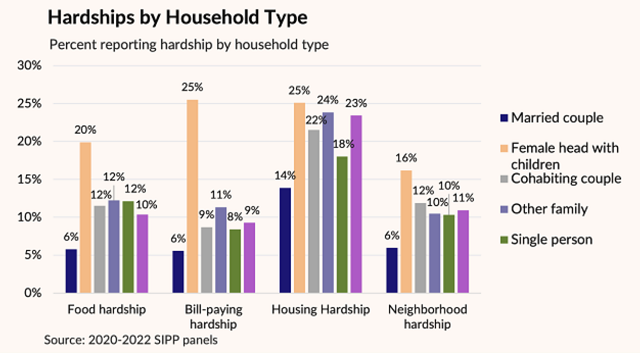Highlights
- Married-couple households experience fewer hardships than other households while single-parent families with kids experience the most. Post This
- Per a new study, the biggest reason for the married-couple advantage is wealth—married couples often have more savings and assets to fall back on. Post This
- A more moderate portion of the married-couple household advantage reflects the selection of more fortunate demographic and socioeconomic groups into marriage. Post This
Married-couple households are more affluent and experience fewer hardships than other types of households, such as single-parent families or people living on their own. Our new research brief, based on our paper in Demographic Research, explores why, focusing on differences across household types in income, non-income resources, such as wealth, and demographic and socioeconomic characteristics, such as age and education.
Over the past several decades, there has been a decline in the share of households headed by married couples and a corresponding increase in the diversity of household living arrangements, including increases in cohabitation, single-parent families, and non-family households. While this trend partly reflects people’s preferences, it may have negative economic consequences, since married-couple households generally have higher incomes and lower poverty rates than other types of households.
While disparities in income and poverty across households are well-known, there is growing interest in hardship measures to better understand well-being. Unlike poverty measures, which focus on whether income appears sufficient to meet basic needs, hardship measures capture the real-life challenges people face—such as difficulty paying bills or living in poor housing conditions. These measures offer a more direct view of how households experience financial strain. A relatively small number of studies have examined the link between household living arrangements and hardship and they generally show that married-couple households are less likely to experience hardship than other household types.
We build on this research by examining how much of the variation in hardship across household types can be explained by differences in income, non-income resources such as wealth, and demographic and socioeconomic characteristics, such as age, race, and education. Since all these factors are linked to hardship, they are expected to help explain why some household types experience more hardship than others. Importantly, differences in income and wealth are partly caused by differences in household living arrangements. For instance, married-couple households often have two earners, which typically put them at an advantage over single-parent families and people living alone for earning more income and accruing more wealth over time. In contrast, sociodemographic characteristics such as education represent the selection of people into different household types. People with bachelor’s degrees are more likely to get married than people with less than a high school degree. Thus, married couples might experience less hardship only because they have these advantaged characteristics, rather than marriage itself leading to less hardship.
We investigated these issues using 2021 data from the Survey of Income and Program Participation, which contain detailed information on household living arrangements, hardships, and other household characteristics. Our analysis included four summary measures of hardship representing bill-paying hardship, housing hardship, food hardship, and neighborhood problems. We compared six types of households: married-couple households, cohabiting households, single-parent households, nonfamily households, and people living alone. We began by examining the association between hardship and household living arrangements. We then conducted decomposition analyses to determine how much of the disparity in hardship across household types could be explained by differences in income, non-income resources, demographic characteristics, and socioeconomic characteristics.
We find that married-couple households experience fewer hardships than other households while single-parent families with children experience the most. Other household types, such as cohabiting couples and people living alone, fall in between. The biggest reason for the married-couple advantage is wealth—married couples often have more savings and assets to fall back on. Income also plays a significant role, followed by demographic and socioeconomic characteristics.


In short, the income- and wealth-building capacity of married-couple households are important for helping them avoid hardships. Meanwhile, a more moderate portion of the married-couple household advantage reflects the selection of more fortunate demographic and socioeconomic groups into marriage—for instance, people with higher levels of education are more likely to marry than others.
Download the full research brief here.










